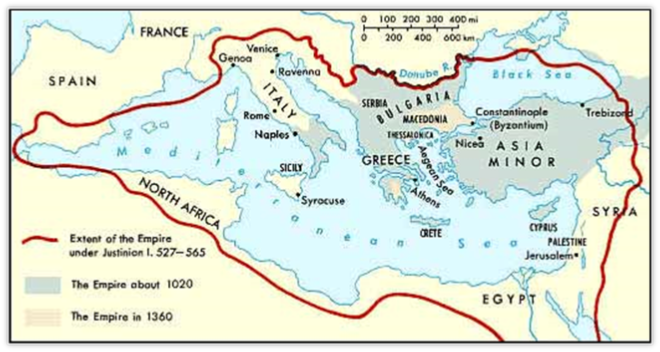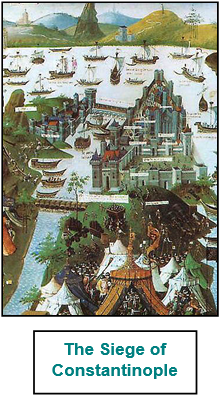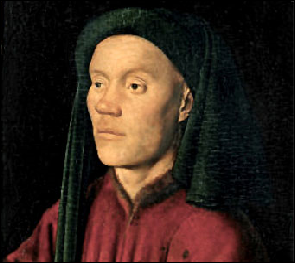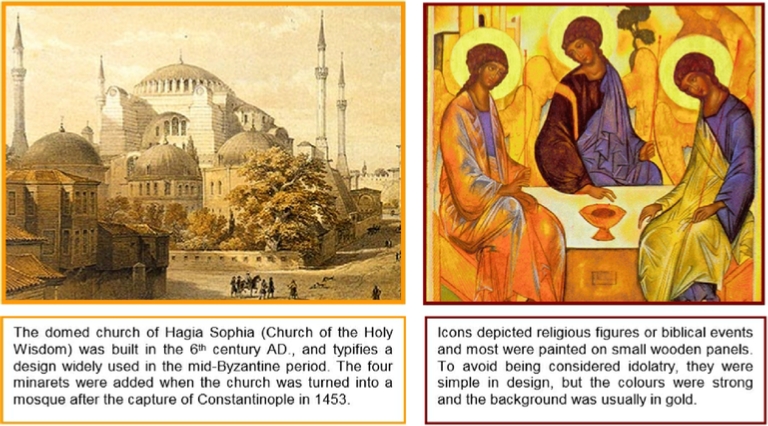


THE BYZANTINE EMPIRE AND THE FALL OF
CONSTANTINOPLE 1453 (H6)
xxxxxThe Byzantine Empire, established in 330, was virtually destroyed by the Fourth Crusade in 1204. The Crusaders turned against the Byzantines, sacked Constantinople, and divided the empire among the victors. As we have seen, in 1261 (H3) Michael VIII of Nicaea attempted a recovery, but by the end of the 14th century, the empire, centred around Constantinople, was fearing the advance of the Ottoman Turks. The defeat of the Ottomans by the warrior Tamerlane at the Battle of Ankara in 1403 gave a short respite for the empire, but under their two powerful leaders, Mehmed I and then Murad II, the Turks resumed their advance, and by 1451 all but Constantinople had been taken. In 1453 the new Sultan, Mehmed II, captured the city. He established Moslem rule, but he proved to be an enlightened despot. He encouraged religious toleration and rebuilt much of the city. By the time of his death in 1481, as we shall see (1468 E4), the Ottoman Empire covered a vast area in Eastern Europe and the Middle East. Learning within the Byzantine Empire, both in the arts and sciences, was maintained by the Greek and Slav people, or found its way to Italy, whilst Byzantine art and architecture survived in the Orthodox Church.
aaaaaIt was in 330 that the
Roman Emperor Constantine, the first Christian emperor, moved his
capital to the old Greek city of Byzantium, renamed Constantinople
in his honour. When Rome fell to the barbarian invasions in 476 it
was the Byzantine Empire - world. This it did with varying degrees of success and failure, but
by 1071, following the victory of the Seljuk Turks at the Battle of
Manzikert, the fortunes of the Empire were at their lowest ebb.
Indeed, the very survival of the empire was in doubt, threatened as
it was on all sides.
world. This it did with varying degrees of success and failure, but
by 1071, following the victory of the Seljuk Turks at the Battle of
Manzikert, the fortunes of the Empire were at their lowest ebb.
Indeed, the very survival of the empire was in doubt, threatened as
it was on all sides.
aaaaaA degree of recovery was
made following the success of the First Crusade, but in 1204 the
Fourth Crusade turned against the Byzantines. Constantinople was
ruthlessly sacked and during the Latin Rule, the Empire was divided
up amongst the victors and virtually destroyed. As we have seen in 1261 (H3)
Michael VIII, the Greek Emperor of Nicaea, seized the capital and
attempted to restore something of its former prestige, but to no
avail. By the mid-
aaaaaThe defeat of the Ottomans
by the Mongol warrior Tamerlane at the Battle of Ankara in 1403
brought an unexpected respite for the beleaguered Empire, but once Mehmed I had come to power in
1413, the Ottomans were once again on the march. Hexand
then his successor, Murad II, becoming Sultan in 1421, continued to expand into
south-
aaaaaWhen the new Sultan, Mehmed II, came to power in 1451 his plan of action
was predictable. He laid siege to Constantinople in April 1453
with a land and sea force of some 150,000 men. Venetians and Genoese
were among the city's 8,000 defenders, but by the end of May the
walls of the city had been breached by artillery, the capital had
fallen, and Emperor Constantine XI was dead. Three days of looting
followed, but the city was spared excessive damage, and once in
control Mehmed II initiated schemes to improve public buildings and
the capital's services. Because many had fled the city, he also
sought to bring in people from all quarters of the empire, together
with Christians and the large number of European Jews who were
fleeing from persecution. To retain these people, the major
religious groups were allowed to establish their own communities and
were put specifically under the Sultan's protection. Meanwhile, the
Ottoman advance continued. By 1460 both Serbia and Morea (southern
Greece) were part of the growing Ottoman Empire and, as we shall see (1468 E4), Mehmed II’s later
campaigns culminated
in an Empire that stretched from the Danube to the Euphrates and
from the Crimea to the Aegean Sea.
the new Sultan, Mehmed II, came to power in 1451 his plan of action
was predictable. He laid siege to Constantinople in April 1453
with a land and sea force of some 150,000 men. Venetians and Genoese
were among the city's 8,000 defenders, but by the end of May the
walls of the city had been breached by artillery, the capital had
fallen, and Emperor Constantine XI was dead. Three days of looting
followed, but the city was spared excessive damage, and once in
control Mehmed II initiated schemes to improve public buildings and
the capital's services. Because many had fled the city, he also
sought to bring in people from all quarters of the empire, together
with Christians and the large number of European Jews who were
fleeing from persecution. To retain these people, the major
religious groups were allowed to establish their own communities and
were put specifically under the Sultan's protection. Meanwhile, the
Ottoman advance continued. By 1460 both Serbia and Morea (southern
Greece) were part of the growing Ottoman Empire and, as we shall see (1468 E4), Mehmed II’s later
campaigns culminated
in an Empire that stretched from the Danube to the Euphrates and
from the Crimea to the Aegean Sea.
aaaaaThus came to an end the Eastern Roman Empire, established as early as the 4th Century AD and, at one time, a powerful force throughout the known world. The preservation of ancient Greek manuscripts and the culture they contained was perhaps the most important contribution made by Byzantium. Fortunately, the fall of Constantinople did not mean an end to this precious heritage. The knowledge accrued in literature, philosophy, mathematics, astronomy and history survived among the Greek and Slavic peoples within the new Muslim empire, and was also carried to Italy where it provided the very stuff of which the renaissance movement was being made. And the wealth and beauty of Byzantine architecture and art was not totally lost. Many parts of the eastern or Orthodox world, especially Russia, continued to build in the same style, and the skills required in icon painting and the making of mosaics survived, albeit on a smaller scale.
Including:
Guillaume Dufay




Acknowledgements
Map (Mediterranean):
licensed under the Creative Commons –
eslhelp.wikispaces.com/The+Byzantine+Empire. The Siege: miniature, 1455, in The Voyage
Overseas by the Burgundian pilgrim Bertrandon de la
Broquière (1400-
H6-
aaaaaIncidentally, five years after the fall of Constantinople, Aeneas
Silvius was elected pope as Pius II (1458-
aaaaaA year after the Muslim victory of 1453, a Lamentation
for the Church in Constantinople was
produced by the French composer Guillaume
Dufay (c1400-
the Muslim victory of 1453, a Lamentation
for the Church in Constantinople was
produced by the French composer Guillaume
Dufay (c1400-
aaaaaDufay was
probably born in Cambrai in north-
